For those who think cities in India are hectic, try cycling through them. Those whimsical rainbow-colored buses playing Mr. Softee music don’t seem so sweet when they’re barreling at you at 100 mph. Tuk tuks zoom past, their obnoxious honking your only warning to get the hell out of the way, while mac trucks speed by so close that if you breathe too deeply you’ll touch their rusty metal.
Despite almost eating pavement while bouncing over pot holes and rough terrain trying to get away from manic drivers, I absolutely encourage everyone to give biking through India a try. Think I’m crazy? Keep reading.
Living in Brooklyn, my friends often tell me I’m nuts for using my bicycle as my main mode of transportation. Sure, the first time a city bus got a mere centimeter from my arm, or a taxi driver cut me off while giving me the finger, I felt nervous; however, it’s how I feel the pulse of the city best. On bike or on foot.
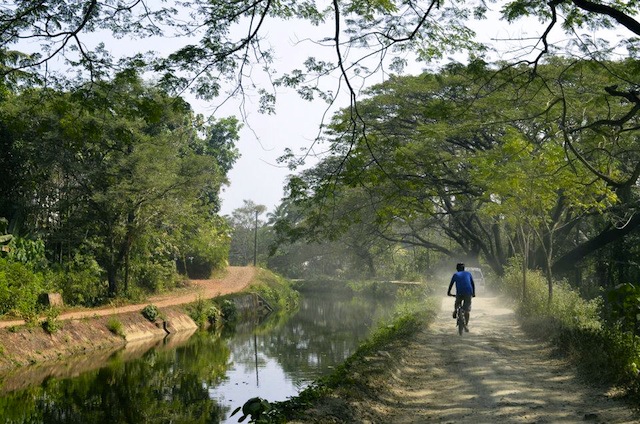
Biking the Canal Route in Kerala, India
Biking The Canal Route
With my Kalypso Adventures guide, Rattan, leading the way, I burn off the previous night’s indulgent chicken curry dinner with steep uphill climbs and pure adrenaline as we speed alongside traffic, passing through strips of calm when we enter the odd small village or rubber tree plantation (Kerala, the state I’m traveling through, is FULL of rubber trees). Our driver, Peter, makes frequent stops to keep our sugar up with oranges, bananas and a local snack called Chikki consisting of groundnuts coated in jaggery.
Suddenly, gravel, gas stations and furniture stores become a single dirt road alongside a peaceful canal.
“There are no more trucks from here on out,” smiles Peter, handing me a banana. “We’ve reached the Canal Route.”
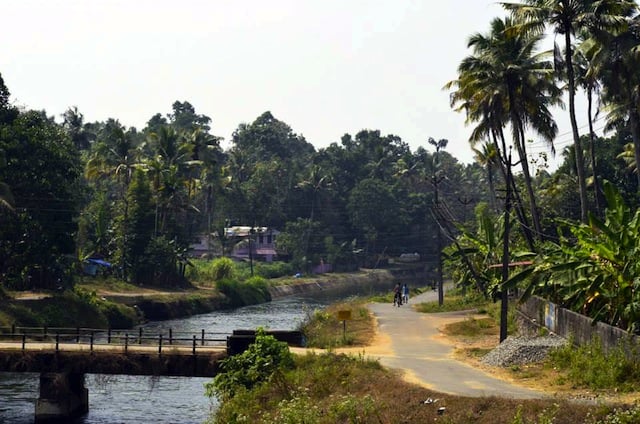
Kerala’s Canal Route
From our beginning point of Kochi to our final destination of Thattekkad — where I would be staying at the nature-infused Hornbill Camp — the journey is a total of 60 kilometers (37 miles). Most of the route was on this road, where hectic India transforms into idyllic India.
While Thailand is known as the “Land of Smiles,” I think they should think about sharing this nickname with Kerala. Here, people are friendly and will help a complete stranger without wanting anything in return. Additionally, they value appearance, both in terms of their clothing and hygiene as well as their homes, which are all colorfully constructed in pinks, purples, yellows and blues, many overflowing with bright red hibiscus.
“People in Kerala don’t like barren land. Instead, they like to use it to plant crops, flowers and spices,” explains Rattan. “In fact, most people have at least two spices growing in their gardens. And the hibiscus can be combined with oil to use to make hair silky.”
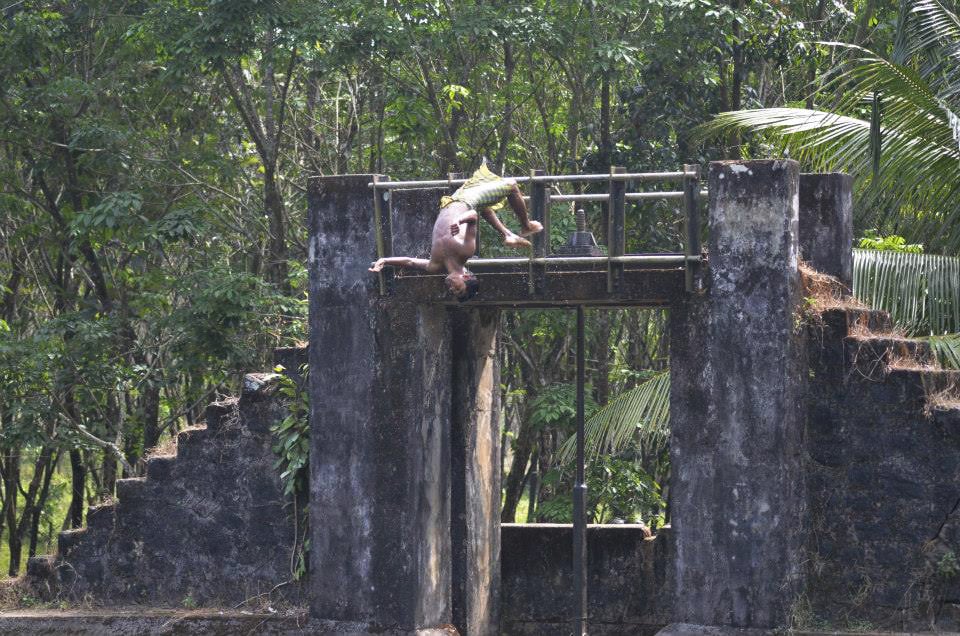
A young local along the Canal Route doing back flips into the water
Meeting The Locals
This is why I love cycling. Because I can see these homes up close, watching the locals who inhabit them bathing and doing laundry in the river. Children swim and race each other in the water, waving frantically and shouting greetings as I pass by. Some even run up and grab my hand when we stop for a snack. Spring-colored houses, billowing palms, pineapple fields, banana trees and tapioca plants take over the landscape, with sweet scents of fruit salad mixing with burnt grass as local women clean up the roads by setting fire to overgrowth.
Along with Peter’s offerings, I get to sample the prevalent local pineapple. While cycling, a group of young children about seven years old come running into the street holding a silver platter full of golden slices.
“Here! Here!” they shout.
My instinct is to assume they want me to purchase the fruits and am ready to decline; however, when I see Rattan reach over and grab one without stopping, I do the same.
“Thank you!” I shout, taking one of the fruits and plopping it into my mouth without stopping (Side note, I feel pretty proud as I didn’t even know I manage that without falling!).
I’d never seen such big smiles and energetic waves as I take the snack from them. They don’t want money, just to share something delicious with some visitors.
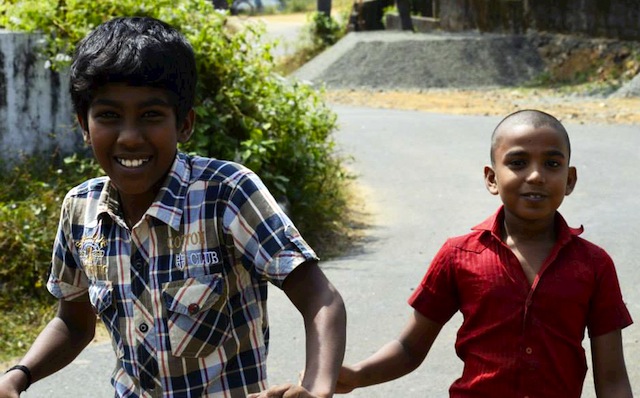
Happy children along the Canal Route
These aren’t the only locals I meet, as the scenic cycling journey along the water quickly turns into a local meet-and-greet. Every time I stop for water, locals — both young and old — run out to say hello to me, asking what my name is and if I enjoy India. A group of young men have me take action shots of them doing back flips off stone bridges into the canal, while two brothers ask if they can cycle alongside me. When I take a break under a tree, I am startled to find some friendly kids perched at the top, waving down at me with wide grins and enthusiastic giggles.
Bus Tours vs Cycling
On a bus I wouldn’t have been able to experience this side of India, not only because the vehicle wouldn’t have fit on the narrow down path along the canal, but also because my senses would have been enclosed by glass. You can’t smell the ripe cocoa beans, hear the beating of a just-washed shirt shirt against concrete or feel the handshake of a child from behind smudged plexiglass. The cows, chickens, goats and ducks that litter the route become almost like paintings instead of wildlife from the plush seat of your vehicle, the windows fading their colors. And while you may see a young woman’s smile as she turns from the river to say hello, the energy from her inner happiness will have dissipated by the time it reaches you in your rolling box.
On a bike, however, you become immersed in all the sights, sounds, tastes, scents and feelings of a place. You don’t just view, you interact with your surroundings. You don’t just see the landscape, it sees you, too.
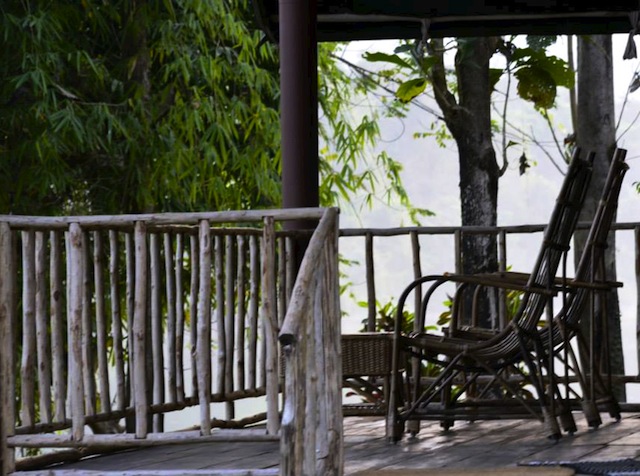
Hornbill Camp cottage tent deck
The Hornbill Camp
This theme of total immersion continues as I reach my destination, the Hornbill Camp. Set on the gentle River Periyar — Kerala’s longest river at 244 kilometers (152 miles)– the rustically luxurious accommodation resides on a working organic plantation and directly across from the Thattekkad Bird Sanctuary, home to over 260 bird species. Talk to any of the staff at Hornbill Camp and you’ll undoubtedly be chatting with a bird-enthusiast who can rattle off “Large-billed Leaf-warbler” and “jungle babbler” just from hearing the animal’s song.
After a hearty buffet lunch of dahl, rice, various curries, beans, fried chicken, bananas, and tapioca pudding — all made with local ingredients — I set off with Chris and John, two nature-enthusiasts at the camp who will be taking me on a tour of the organic plantation. While onsite you’ll find everything from pineapples to coffee to jack fruit to nutmeg, the main crop is rubber. You can identify it by the plastic ring around the trunk, which helps trees heal by shading them from moisture after they’ve been shaved down. It’s amazing to see how, with just a shallow cut, the tree will start oozing liquid rubber, which rolls down the cut bark and into a container. I also see the small factory where rubber sheets are produced to be sold to manufacturers.
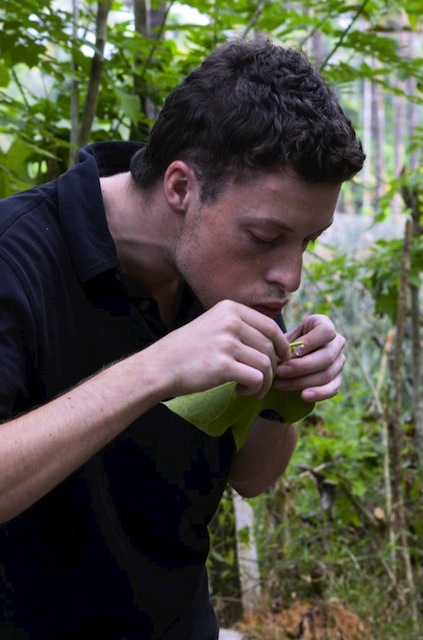
Learning to blow bubbles with Jatropha plants at the Hornbill Camp
For me, the most interesting part of the hike is learning how the myriad plants growing on the property are used by locals. For example, while Jatropha plants make biodiesel and bubbles (yes, the ones you loved as a kid), turmeric is a great antiseptic. Then there’s Mimosa Pelorus, which shrivels up when touched as a defense mechanism and is also used in Ayurvedic medicine. Nutmeg can cure an upset stomach, clove helps with tooth and gum pain, and Clerodendrum is used to cure malaria.
Afterward, I’m immersed in local wildlife culture through a kayaking excursion through the bird sanctuary, where I spy Snakebirds, Dollarbirds, Cormorants, Parakeets, Crimson-backed Sunbird and Wynaad Laughingthrush, as well as monkeys and the world’s largest squirrel, the Malabar Giant Squirrel. I even see a local riding a wooden canoe with his dog! Best of all, the beautiful songs I hear from the birds while kayaking are the exact sounds that drift me off to sleep at night and wake me in the morning. For those who like to disconnect with technology (there’s no WiFi here!) and reconnect with themselves and nature, this is paradise at its finest.
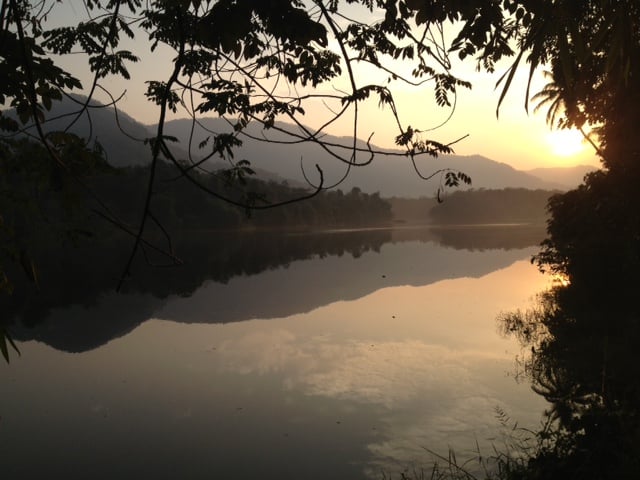
Hornbill Camp sunrise
I find myself truly appreciating the peacefulness of where I am due to the fact I biked there. Hornbill Camp focuses on healthy living, active lifestyles, local culture and immersion in nature, which is exactly what cycling to the camp put me in the mindset to experience. Additionally, the ride gave me a taste of Kerala that I could further enhance through a stay at Hornbill. At night, I fall asleep quickly due to the day’s activities and the lullabyes of the birds and tree frogs, but also excited for the next day’s adventures: trekking in the Silent Valley National Park.
Stay tuned for more Bus-Free Through India, with new articles in this 8-part series coming out every Tuesday!
This post is based on a partially-hosted press trip I took with Kalypso Adventures, experiencing a section of their Multi Activity Holiday tour. It’s part of a series called Bus-Free Through India, as the tour focuses on showcasing the real India through cultural, sustainable and adventurous offerings, as well as traveling from place to place by cycling, trekking and kayaking with qualified guys. Stay tuned for this next chapter in my series, Bus-Free Through India.

Jessica Festa is the editor of the travel sites Jessie on a Journey (http://jessieonajourney.com) and Epicure & Culture (http://epicureandculture.com). Along with blogging at We Blog The World, her byline has appeared in publications like Huffington Post, Gadling, Fodor’s, Travel + Escape, Matador, Viator, The Culture-Ist and many others. After getting her BA/MA in Communication from the State University of New York at Albany, she realized she wasn’t really to stop backpacking and made travel her full time job. Some of her most memorable experiences include studying abroad in Sydney, teaching English in Thailand, doing orphanage work in Ghana, hiking her way through South America and traveling solo through Europe. She has a passion for backpacking, adventure, hiking, wine and getting off the beaten path.








